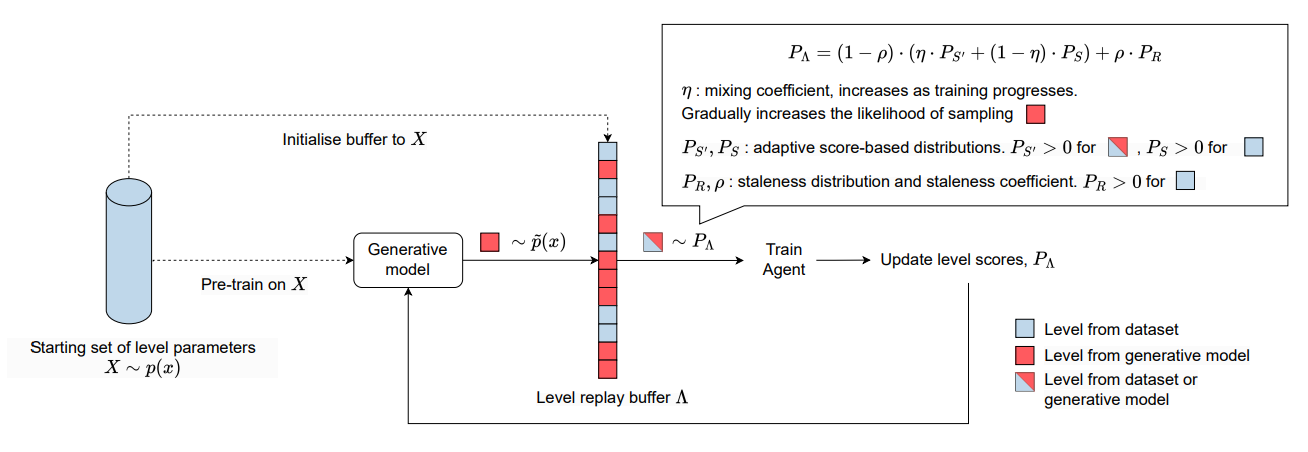 This codebase contains a Pytorch implementation of DRED: Zero-Shot Transfer in Reinforcement Learning via Data-Regularised Environment Design (ICML 2024). It consists of:
This codebase contains a Pytorch implementation of DRED: Zero-Shot Transfer in Reinforcement Learning via Data-Regularised Environment Design (ICML 2024). It consists of:
- Implementations for the VAE-DRED and EL-DRED algorithms introduced in the DRED paper. We provide configuration files to reproduce the main experiments in the paper.
- A customisable and extensible framework for specifying and generating large datasets of diverse MiniGrid environments. These environments are procedurally generated using the Wave Function Collapse algorithm.
- A Variational AutoEncoder (VAE) implementation trainable on these datasets. The VAE acts as the generative model of MiniGrid environments in VAE-DRED.
- Benchmarking of DRED against various Unsupervised Environment Design (UED) algorithms, reproduced from the Dual Curriculum Design (DCD) repository.
This codebase is designed to be extensible, allowing for easy integration of new environments, generative models and DRED algorithms.
We are committed to the pursuit of reproducibility and transparency in ML research. To this end, we provide our experimental data, including model checkpoints, datasets, experiment logs and the code for reproducing the figures in Garcin et al, 2024 openly available. See Additional resources for the relevant download links.
If you use this code to develop your own DRED algorithms, or if you use VAE-DRED, EL-DRED, the MiniGrid dataset generation framework, the provided VAE implementation, or the CaveEscape and Dataset Minigrid environments in academic contexts, please cite
Garcin et al, "DRED: Zero-Shot Transfer in Reinforcement Learning via Data-Regularised Environment Design", 2024.
If you use the reproduced UED algorithms or any environment not mentioned above, please refer to the citation guidelines in the DCD repository.
To install the necessary dependencies, run the following commands:
git clone https://github.com/uoe-agents/dred.git
cd dred
conda create -n dred python=3.8
conda activate dred
conda install cudatoolkit=11.3 -c pytorch
conda install -c dglteam dgl-cuda11.3
pip install -r requirements.txt
git clone https://github.com/openai/baselines.git
cd baselines
pip install -e .
pip install pyglet==1.5.11 numpy==1.23.4
EL-DRED requires an environment dataset to be present in the datasets directory. VAE-DRED
requires an environment dataset and a pre-trained VAE model checkpoint. The VAE model checkpoint should be placed in the
dred_pretrained_models directory. We provide instructions on how to either:
- install additional dependencies required to directly generate MiniGrid datasets and train a VAE model from scratch.
- download a dataset and the pre-trained VAE model weights.
The required additional dependencies are installed using the following commands:
cd minigrid_level_generation/data_generation/generation_algorithms
git clone https://github.com/francelico/wfc_2019f.git
pip install -r requirements-extra.txt
Alternatively, we provide the option to download the datasets and the VAE model weights used in Garcin et al, 2024.
- Download at least one of the datasets from our Minigrid dataset repository. The dataset used to train the agent in our publication is the
cave_escape_512_4ts_varpdataset. Unzip the.ziparchive and place the resultingcave_escape_512_4ts_varpfolder in thedatasetsdirectory. - The pre-trained VAE model can be obtained from our DRED data repository. Download
the
dred_pretrained_vae.ziparchive, unzip its contents and place the resultingdred_pretrained_vae.ptcheckpoint in thedred_pretrained_modelsdirectory. This model is meant to be paired with thecave_escape_512_4ts_varpdataset as it was pre-trained on this dataset.
Note: The minigrid_dense_graph_1M dataset in the dataset repository contains 1.5 million procedurally MiniGrid generated environments, and
will take $\sim$25 Gb of disk space once unzipped. Its main purpose is to speed up the creation of new
datasets by bootstrapping the generation process. If you don't plan to generate additional datasets you can skip
downloading this dataset.
You can test dataset generation from scratch by running the following command (you may remove +multiprocessing=1
to disable multi-threaded generation):
python -m minigrid_dataset_generation models=data_generation +data_generation=cave_escape_8_4ts_varp_from_scratch
+multiprocessing=1
To test dataset generation using pre-generated layouts, which is significantly less computationally expensive for
large datasets, download the minigrid_dense_graph_1M dataset and place it in the datasets directory. Then, run the
following command:
python -m minigrid_dataset_generation models=data_generation +data_generation=cave_escape_8_4ts_varp
+multiprocessing=1
You can test VAE pre-training with
python -m pretrain_generative_model run_name=test_vae_pretraining dataset=cave_escape_8_4ts_varp
model=res_graphVAE_ce.yaml accelerator=gpu epochs=1 run_post_training_eval=False
If you did not do so already, download the cave_escape_512_4ts_varp dataset and the pre-trained VAE weights using
the instructions above, and place them in the appropriate directories.
train_scripts/grid_configs/minigrid/cave_escape/test_vae_dred.json contains a test configuration for VAE-DRED that
should complete in less than 10 minutes on a GPU-equipped laptop. You can generate the command to run this test
configuration with
eval `python train_scripts/make_cmd.py --json minigrid/cave_escape/test_vae_dred.json --no_linebreaks --num_trials 1`
Training agents using DRED with train.py
The VAE-DRED and EL-DRED algorithms are specified by the following command-line arguments:
| Argument | VAE-DRED | EL-DRED |
|---|---|---|
ued_algo |
dred |
dred |
use_dataset |
true |
true |
level_replay_strategy_support |
dataset_levels |
dataset_levels |
level_replay_secondary_strategy |
grounded_value_l1 |
grounded_value_l1 |
level_replay_secondary_strategy_support |
buffer |
buffer |
level_replay_secondary_strategy_coef_end |
1.0 |
1.0 |
level_replay_schedule |
fixed |
fixed |
ued_editor |
true |
true |
level_editor_method |
generative_model |
random |
Note that a valid path to a MiniGrid dataset must be specified using the dataset_path argument. For VAE-DRED, a valid path to a VAE model checkpoint must also be provided using the generative_model_path argument.
You may also generate the full combination of command-line arguments using provided JSON configuration files in train_scripts/grid_configs/minigrid/cave_escape. To obtain the command that launches 1 run described by the relevant configuration file config.json, run the command below:
python train_scripts/make_cmd.py --json config --num_trials 1Alternatively, you can run the following to copy the command directly to your clipboard:
python train_scripts/make_cmd.py --json config --num_trials 1 | pbcopyUse these configuration files to reproduce experiments from Garcin et al, 2024:
| Method | json config |
|---|---|
| VAE-DRED | mg_ce_dataset_vae_dred.json |
| EL-DRED | mg_ce_dataset_el_dred.json |
|
|
mg_ce_dataset_uni.json |
| PLR | mg_ce_dataset_plr.json |
| ACCEL | mg_ce_60b_uni_accel_empty.json |
| ACCEL-D (ACCEL with dataset initialisation) | mg_ce_dataset_accel.json |
| RPLR | mg_ce_60b_uni_robust_plr.json |
| DR | mg_ce_60b_uni_dr.json |
By default, train.py generates a folder in the directory specified by the --log_dir argument, named according to --xpid. This folder contains the main training logs, logs.csv, and periodic screenshots of generated levels in the directory screenshots. Each screenshot uses the naming convention update_<number of PPO updates>.png. When --use_editor is provided (i.e. for VAE-DRED, EL-DRED or ACCEL), the screenshot naming convention also includes information about whether the original level was obtained from the replay buffer and how many editing cycles led to this level.
Latest checkpoint
The latest model checkpoint is saved as model.tar. The model is checkpointed every --checkpoint_interval number
of updates. When setting --checkpoint_basis=num_updates (default), the checkpoint interval corresponds to the
number of rollout cycles (which includes one rollout for each student and teacher). Otherwise, when
--checkpoint_basis=student_grad_updates, the checkpoint interval corresponds to the number of PPO updates
performed by the student agent only. The student_grad_updates checkpoint basis allows comparing methods based on
number of gradient updates actually performed by the student agent, which can differ from number of rollout cycles, as student gradient updates are not performed every rollout cycle in DRED. This is also the case for UED algorithms such as Robust PLR or ACCEL.
Archived checkpoints
Separate archived model checkpoints can be saved at specific intervals by specifying a positive value for the argument --archive_interval. For example, setting --archive_interval=1250 and --checkpoint_basis=student_grad_updates will result in saving model checkpoints named model_1250.tar, model_2500.tar, and so on. These archived models are saved in addition to model.tar, which always stores the latest checkpoint, based on --checkpoint_interval.
Generating MiniGrid datasets with minigrid_dataset_generation.py
We provide a framework for procedurally generating large datasets of diverse MiniGrid environments with specifiable
semantics. Dataset are saved in the datasets directory. Each dataset is stored in a separate directory, with the
dataset name corresponding to the name of the YAML configuration file used to generate it. The dataset directory contains the following files:
dataset.meta: metadata file containing information about the datasetbatch_X.data/test_batch_X.data: files containing batches of levels from the train or test subsets, encoded as DGL graphs.batch_X.data.meta/test_batch_X.data.meta: metadata files containing information about their corresponding batch files, including each level graph re-encoded as numpy arrays directly compatible with MiniGrid.batch_X.data.dgl.extra/test_batch_X.data.dgl.extra: additional batch metadata encoded as DGL graphs. This metadata is stored separately from the rest of the metadata for storage efficiency reasons.layouts.png: rendering of sampled levels from the dataset.
The dataset generation process is controlled via YAML configuration files in
minigrid_level_generation/conf/data_generation. To generate a dataset described by a configuration file config.yaml, run the following command:
python -m minigrid_dataset_generation models=data_generation +data_generation=configFor each environment being generated, the generation process takes place in two stages:
- Layout generation: The layout of the environment is generated using the Wave Function Collapse (WFC) algorithm.
- Addition of objects and tiles: The layout is populated with objects and tiles, following a distribution specified by the user. This distribution can be designed to create shared semantics across environments in the dataset.
We provide a brief overview of each stage below, and recommend reading comments in
cave_escape_8_4ts_varp_from_scratch.yamlfor a detailed explanation of the generation parameters.
WFC allows to transform a single basic initial template into a multitude of diverse and complex layouts, as can be seen in the examples below.
| Task Structure | Template | Example 15x15 generated layout | Example 45x45 generated layout |
|---|---|---|---|
dungeon_ |
 |
 |
 |
rooms_office |
 |
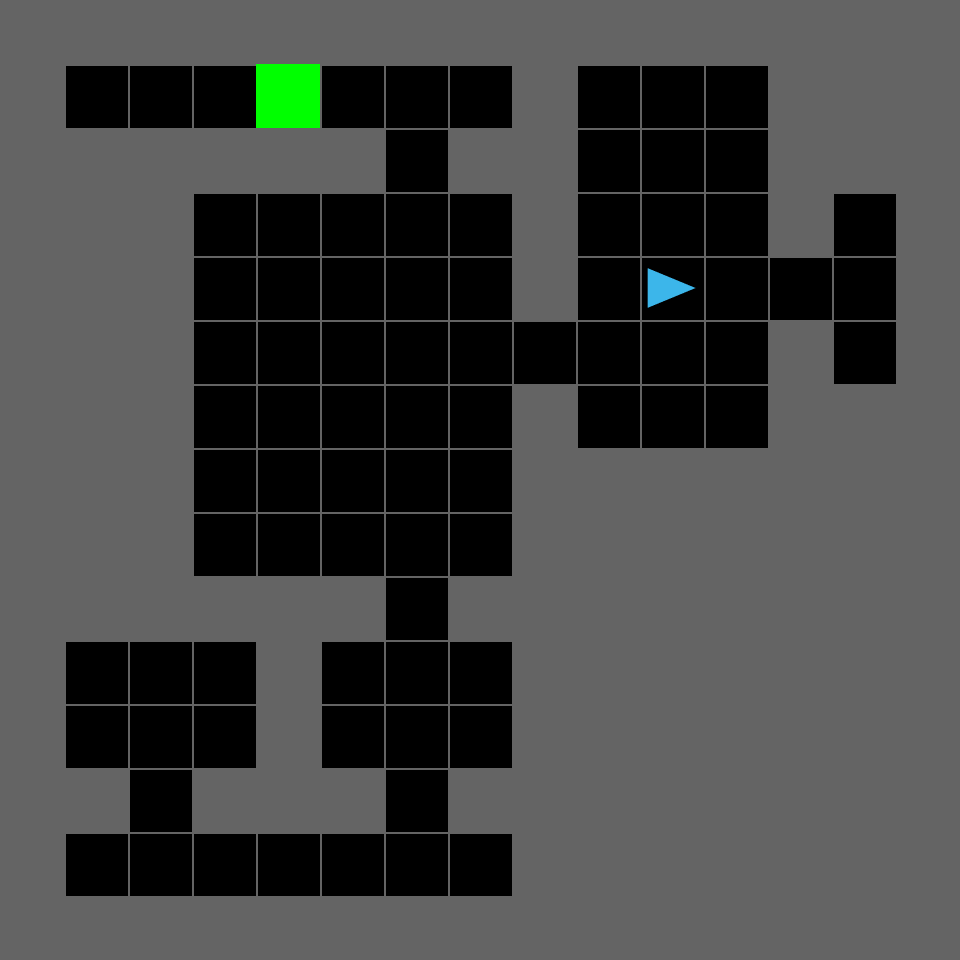 |
 |
skew_2 |
 |
 |
 |
We provide templates and WFC parameter configurations to generate 22 different task structures. You can select the
mix of task structures you would like to generate by specifying the task_structure_split parameter in the YAML
configuration file.
You can also define additional task structures by adding new templates to
minigrid_level_generation/data_generation/templates and YAML configuration files to minigrid_level_generation/conf/task_structure.
Each layout can be populated with MiniGrid objects and tiles according to tile distributions specified by the user.
Currently, only MiniGrid floor tiles (referred to as "moss" tiles) and lava tiles are supported through the
moss_distribution_params
and lava_distribution_params parameters in the YAML configuration file, but the generation
framework can
easily be
extended to
support
additional
object types.
Specifying these distributions contributes to the creation of shared semantics across environments in the dataset. For example the "Cave Escape" layouts below are designed to have moss tiles in the vicinity of the goal, and lava tiles far from the goal.
| Base layout | Cave escape layout |
|---|---|
 |
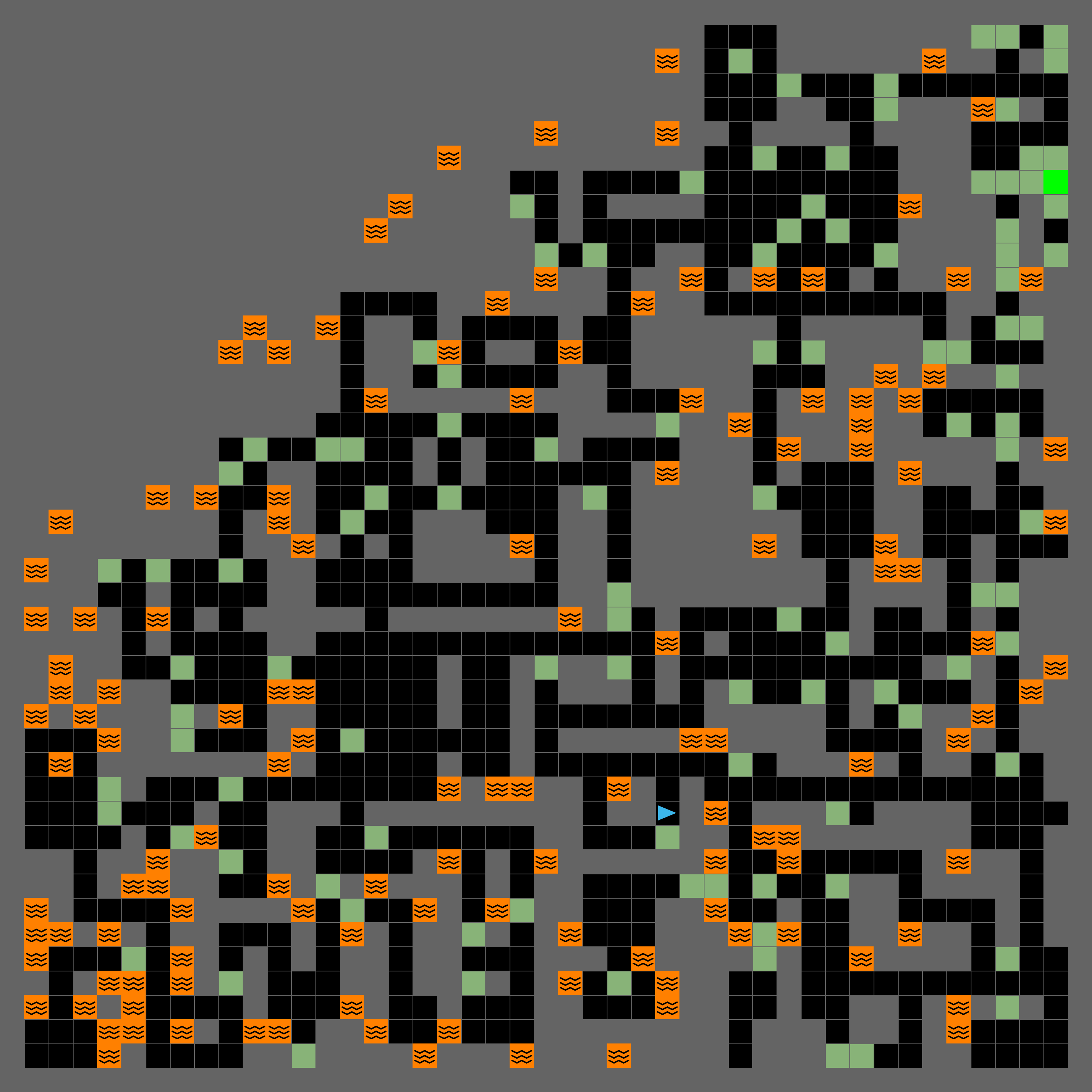 |
 |
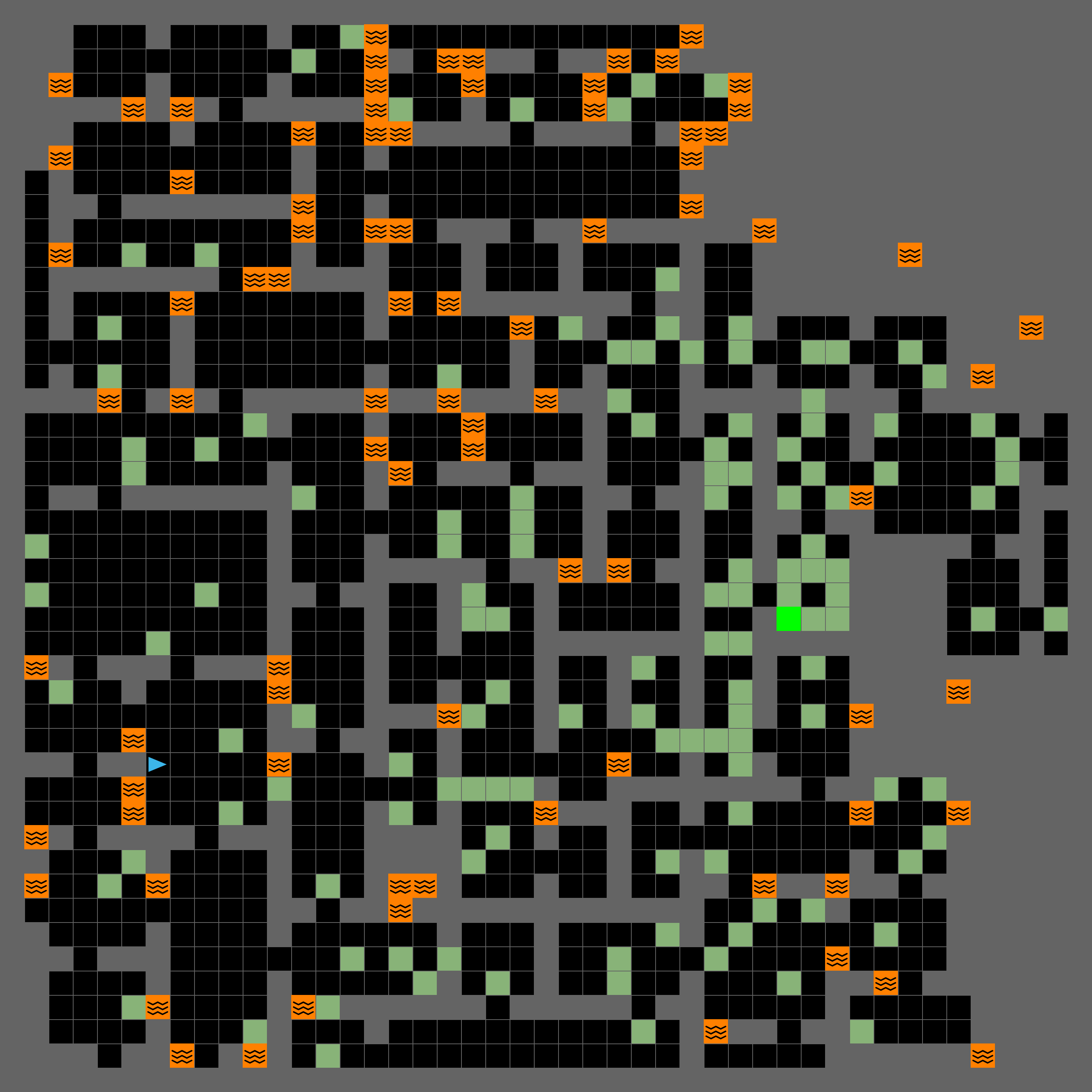 |
 |
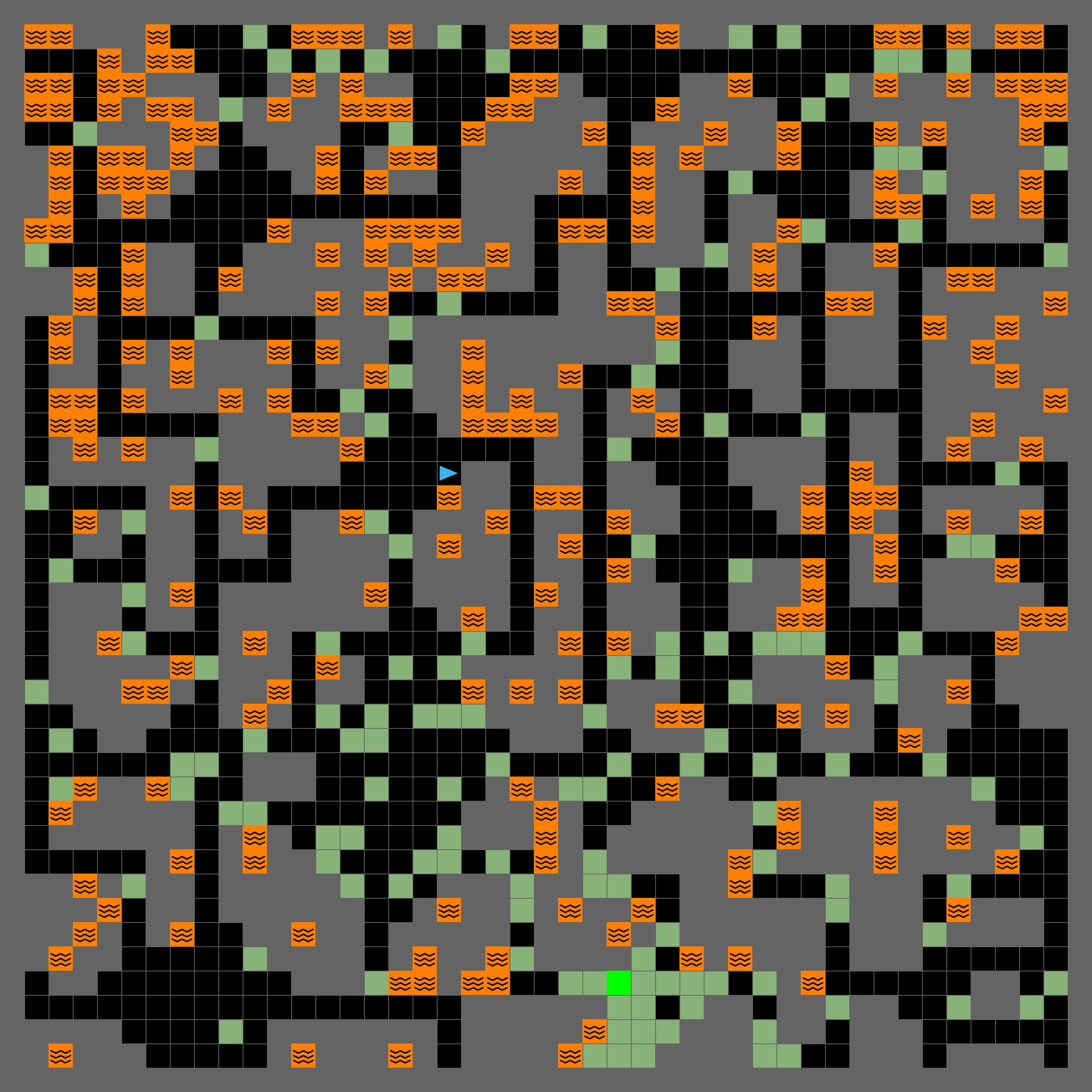 |
WFC procedural generation is computationally expensive. To speed up the generation process, we provide the option to:
- enable multiprocessing: add
+multiprocessing=1 num_cpus=Nto the command line arguments to generate the dataset batches usingNparallel processes. - use pre-generated layouts: you may skip the WFC layout generation step by bootstrapping from an existing
dataset. We provide
minigrid_dense_graph_1M, a dataset of 1.5M pre-generated 15x15 layouts of diverse task structures that is available for download from our MiniGrid dataset repository. After placing this dataset in thedatasetsdirectory, you can use it do generate new datasets by specifying thesource_dataset,train_batch_idsandtest_batch_idsarguments in the YAML configuration file (you can refer tobatch_info.csvin theminigrid_dense_graph_1Mdirectory for a breakdown of which task structures are found in different batch files). Seecave_escape_8_4ts_varp.yamlfor an example configuration file using pre-generated layouts.
Pre-training the VAE on a MiniGrid dataset with pretrain_generative_model.py
Run the following command to train the VAE used in Garcin et al, 2024.
python -m pretrain_generative_model run_name=pretrain_generative_model model=res_graphVAE_ce.yaml
dataset=cave_escape_512_4ts_varp
accelerator=gpu epochs=200 run_post_training_eval=FalseEvaluating RL agents on generated datasets with eval_dataset.py
To evaluate the zero-shot transfer performance of RL agents, we propose an evaluation protocol that measures their
performance
on multiple datasets of unseen environments, each dataset containing hundreds (sometimes thousands) of diverse
environments. We refer the reader to the DCD repository for instructions on how to use eval.py,
which
evaluates agents on
individual hand-crafted environments.
The following command evaluates a <model>.tar in an experiment results directory, <xpid>, located in a base log
output
directory <log_dir>. It will evaluate the agent in datasets <dataset_name1>,
<dataset_name2>,
and <dataset_name3>, running one evaluation episode per environment in each dataset. It will output the results in
a .csv named <output file prefix><model>.csv located in <result_dir>.
python -m eval_dataset \
--base_path=<log dir> \
--result_filename_prefix=<output file prefix> \
--result_path=<output dir> \
--xpid=<xpid> \
--datasets_root=<datasets dir> \
--datasets=<dataset_name1>,<dataset_name2>,<dataset_name3> \
--model_tar=<model>the following command evaluates a <model>.tar in experiment results directories
matching the prefix
<xpid_prefix>. This prefix argument is useful for evaluating models from a set of training runs with the same
hyperparameter settings.
python -m eval_dataset \
--base_path=<log dir> \
--result_filename_prefix=<output file prefix> \
--result_path=<output dir> \
--prefix=<xpid_prefix> \
--datasets_root=<datasets dir> \
--datasets=<dataset_name1>,<dataset_name2>,<dataset_name3> \
--model_tar=<model>Setting --model_tar=all evaluates all models (all files ending in .tar) in experiment results directories
matching the prefix
<xpid_prefix>. It is useful to measure the evolution of the agent's performance over the course of training.
It will output results in multiple .csv files, one for each model checkpoint.
python -m eval_dataset \
--base_path=<log dir> \
--result_filename_prefix=<output file prefix> \
--result_path=<output dir> \
--prefix=<xpid_prefix> \
--datasets_root=<datasets dir> \
--datasets=<dataset_name1>,<dataset_name2>,<dataset_name3> \
--model_tar=all- Our MiniGrid dataset repository contains several MiniGrid datasets.
- Our DRED data repository contains the experiment logs and the plotting code used to generate figures in Garcin et al, 2024. It also contains the VAE model weights for VAE-DRED and model checkpoints saved while training the agent.
- This repository contains the code to reproduce the Procgen experiments in Garcin et al, 2024.
- This blog post provides an introduction to UED and the distinctions between DRED and traditional UED algorithms.
- The DCD repository contains implementations of various UED algorithms, and was the basis for our implementation of DRED.
- Farama's MiniGrid is the official and actively maintained version of MiniGrid. Our WFC-based layout generation was included in MiniGrid 2.4.0.
- WFC layout generation uses the wfc_2019f python implementation.